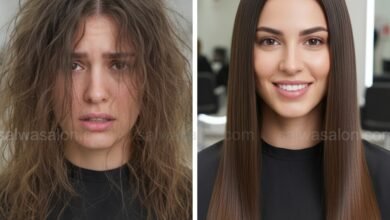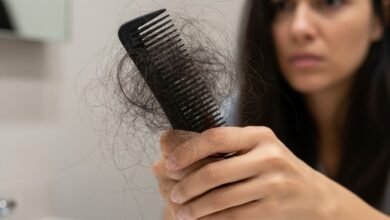In-Depth Analysis: 5 Habits That Trigger Hair Loss & Science-Based Solutions

You may have invested in various premium serums, tonics, and shampoos, yet strands of hair continue to fall. This disappointment often stems not from the wrong products, but from daily habits that systematically weaken the foundation of your hair’s health: the follicles.
At Salwa Salon, we believe that effective hair care begins with a deep understanding of the ‘why’ behind every problem. This article is not just a list, but a comprehensive analysis to help you diagnose and correct the habits that are the root cause of hair loss. Let’s dissect them one by one.
- Hair Styles That Exert Excessive Tension (Traction Alopecia)Hairstyles like tight ponytails, ballerina buns, or cornrows certainly look neat and practical. However, behind this aesthetic lies a significant mechanical risk to your hair follicles.
What Actually Happens to Hair Follicles?
This condition is medically known as Traction Alopecia. It is not ordinary hair loss, but damage caused by constant and prolonged physical pulling on the hair roots. This pulling causes micro-inflammation around the follicles and gradually damages the dermal papilla—a structure at the base of the follicle responsible for supplying blood and nutrients. If it continues, the follicles will shrink (miniaturization), stop producing hair, and eventually become permanent scar tissue.
Practical and Preventive Solutions:
- Vary Hair Styles: Avoid tying your hair in the same style and at the same spot every day. Give your hair a break to hang loose.
- Loosen Ties: If you must tie your hair, ensure the tie is loose enough so there is no sensation of pulling on the scalp.
- Choose the Right Accessories: Replace rough fabric-covered elastic bands with satin hair ties or softer scrunchies. Avoid using metal clips that can pull and break hair shafts.
- Shampoo Water Temperature That Is Too HighA hot shower is a soothing luxury, but for hair and scalp, it is a source of thermal stress. The effects are far more complex than just making hair ‘dry’.
Thermal Impact on Hair and Scalp Structure
High-temperature water acts like a very strong solvent. It dissolves and removes the sebum layer—natural oil that functions as a hydrolipidic protective barrier—from your scalp. Without this protective layer, the scalp becomes vulnerable to dehydration, irritation, and pH imbalance.
At the same time, heat forcibly opens the hair cuticles (outermost layer). Continuously open cuticles will cause the hair shaft to lose its internal moisture, becoming brittle, porous, and prone to breakage. This is why hair often feels rough and tangled after washing with hot water.
Recommended Shampooing Techniques:
- Use Lukewarm Water: The ideal temperature is one that feels comfortable on the skin, warm enough to open the cuticles for cleansing products to work effectively, but not hot enough to strip natural oils.
- Final Rinse with Cold Water: After using conditioner, perform a final rinse with cold water for 10-15 seconds. This will help reseal the cuticles, lock in moisture, and provide natural shine to the hair.
- Aggressive Handling of Wet HairThis is the most common and most damaging mistake often overlooked. Treating wet hair the same way as dry hair is a prime recipe for structural damage.
Why is Wet Hair So Vulnerable?
Structurally, hair is composed of keratin protein bonds. When wet, the hydrogen bonds within the hair cortex become weak and temporarily break. This makes hair very elastic—it can stretch up to 50% of its original length without breaking immediately. However, this elasticity also makes it extremely fragile. Forcefully combing or rubbing it with a towel will stretch it beyond its tolerance limit, causing it to break in the middle of the shaft or even be pulled out from the roots.
Correct Wet Hair Handling Protocol:
- Dry Gently: Replace regular cotton towels with a microfiber towel or an old cotton t-shirt. Instead of rubbing, gently pat and squeeze your hair to absorb excess water.
- Use Detangler Products: Spray a leave-in conditioner or detangling serum to provide a lubricating layer that reduces friction.
- Choose the Right Comb: Use a wide-tooth comb. Avoid using brushes altogether on soaking wet hair.
- Start from the Ends: Begin combing from the ends of the hair to untangle knots, then slowly work your way up to the middle and roots. This technique prevents direct pulling on the follicles.
- Chronic Stress and Its Impact on the Hair Cycle (Telogen Effluvium)The link between stress and hair loss is not a myth, but a measurable physiological response with a specific name: Telogen Effluvium.
Understanding the Hair Growth Cycle
Your hair goes through three main phases: Anagen (active growth phase, 2-7 years), Catagen (transition phase, a few weeks), and Telogen (resting/shedding phase, about 3 months). Under normal conditions, about 85-90% of hair is in the Anagen phase.
Physical stress (such as severe illness, surgery) or intense emotional stress can trigger a surge in cortisol hormone. This cortisol sends signals to a large number of hair follicles to prematurely end the Anagen phase and enter the Telogen phase. As a result, 2-3 months after the stressful period, you will experience massive hair shedding as these hairs complete their resting phase and detach.
Health-Based Mitigation Strategies:
Managing stress is no longer just a lifestyle choice, but a crucial component of hair care. Activities such as meditation, yoga, regular exercise, or taking time for hobbies have been shown to help regulate cortisol levels and maintain a balanced hair growth cycle.
- Micro and Macro Nutrient DeficienciesHair is a non-essential tissue. This means that when the body experiences nutrient deficiencies, it will prioritize nutrient allocation to vital organs (heart, brain) and reduce the supply to hair follicles. A poor diet is a direct invitation for hair loss.
Key Nutrients for Strong Hair Foundation:
- Protein (Amino Acids): Hair is mostly made of a protein called keratin. Insufficient protein intake (meat, fish, eggs, legumes) means the body lacks the main raw material to build strong hair.
- Iron: This mineral is crucial for hemoglobin production in red blood cells, which are responsible for carrying oxygen throughout the body, including to hair follicles. Low iron levels (anemia) are one of the main causes of diffuse hair loss, especially in women.
- Zinc: Zinc plays a vital role in hair tissue growth and repair. It also helps maintain the proper functioning of oil glands around the follicles.
- Biotin and B-Complex Vitamins: Biotin (Vitamin B7) is known to be important for keratin production. Other B vitamins also support the creation of red blood cells that nourish the scalp.
Conclusion: From Habits to Holistic Solutions
Addressing hair loss is not a sprint, but a marathon that requires a holistic approach. The five habits we have discussed—mechanical tension, thermal stress, aggressive handling, physiological stress, and nutrient deficiencies—are often the unseen culprits.
By understanding the science behind each of these habits, you are no longer just following tips, but making informed choices for your hair’s long-term health. Small, consistent changes to your daily routine will yield far more significant results than even the most expensive products.






